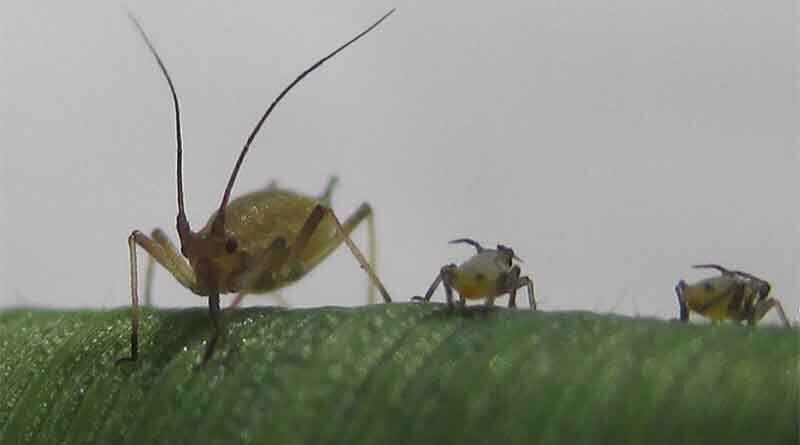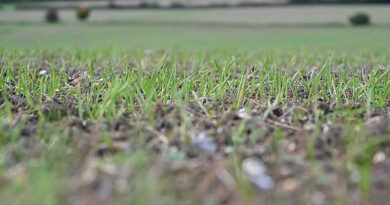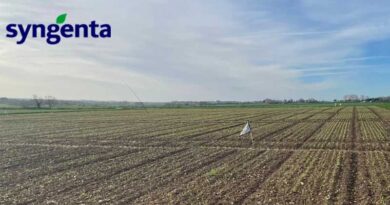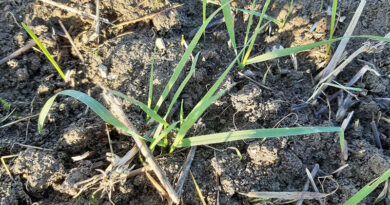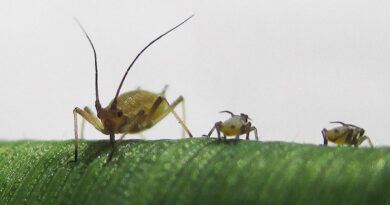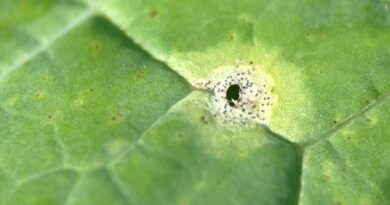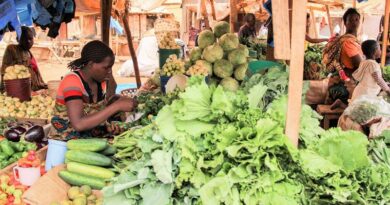Integrated approach to autumn BYDV risks
26 July 2021, UK: With combines rolling in winter barley, the true extent of last season’s BYDV effects are being revealed. Damage is higher than expected in some areas, given the relatively low number of aphids in wet conditions last autumn, reported Syngenta Technical Manager, Dr Max Newbert.
Speaking at a Syngenta Summer season Integrated Pest Management (IPM) webinar, he highlighted how challenging conditions for application last autumn had seen sprays missed, or timed too late to stop infection foci occurring in the crop.
Examples of barley fields sown in mid-September 2020 in the eastern counties(below) that had experienced a spray miss from a single application saw almost total crop loss in the untreated area by the spring, warned Max.
“Further multiple patches and gaps in the treated crop indicated a second application would have been beneficial in a high-risk situation.”
Max outlined a five-point plan for action this autumn, integrating available IPM measures to get on top of BYDV:
- Remove the green bridge
- Delay drilling
- Optimise establishment
- Grow resistant varieties in challenging situations
- Use BYDV Assist to time Hallmark Zeon applications
Removing the green bridge that can carry BYDV infected aphids from old crop to establishing seedlings is essential. “If you are spraying off with glyphosate, it’s important to remember it typically takes two weeks from application for aphids to vacate and move on from green material, so you do have to leave sufficient time – particularly if you are also waiting for more grass weeds to emerge,” he pointed out.

Delayed drilling will give a greater gap and, typically, means less aphid activity at the crop’s most susceptible early growth stages. Sowing from mid-October onwards, generally sees BYDV risks rapidly decline, depending on the area.
Coupled to drilling date, growers could also look at tailoring seed rates, seed treatments and nutrition to optimise establishment in the conditions. “Primary inoculation can be overcome with more plants per m2, or plants can be more resilient with vigorous growth during establishment,” he indicated.

“Furthermore, where some plants are infected and weaker over winter, higher plant populations may be better able to tiller more readily and compensate in the spring, to fill the gaps left by primary infection.”
The opportunity to grow BYDV resistant varieties for both barley and wheat has also added another extra layer of robustness in an IPM approach. But growers still need an insecticide programme, particularly in high-risk situations where they are of most value, he suggested.

“They do fit well if you are drilling very early in difficult to control scenarios, such as fields that have historically always had BYDV issues, even when we had seed treatments.
“However, it is essential to keep pressure as low as possible, to protect against the risk of virus strains adapting to break down the valuable resistance.”
Without the protection of insecticide seed treatments, the timing of any foliar application is now even more important, advocated Max. “Using the BYDV Assist app to track aphid population development in the field – by simply inputting emergence date and location – can give crucial early warning of when to time spray applications to best effect.

“That’s allied to using the optimum application techniques to target aphids in the crop, along with using the best product in Hallmark Zeon, that will give rapid knock-down to prevent virus transmission and highest levels of control to stop populations spreading.”
Max identified that independent monitoring populations of grain aphid (S. avenae) – one of the key vector species of BYDV – had shown an incidence of kdr resistance to pyrethroids had declined markedly over the past seasons, typically to average around 20% across all sites tested for 2019 and 2020. This was notably less compared to results when testing was last done a half a decade ago, showing the effect of fitness costs conveyed by this resistance.

“There is no significant resistance shifts detected in the other aphid species responsible for BYDV transmission,” he added. “However, with fast cycling aphid species, it is important to remain aware of the risk. With Hallmark Zeon, trials have shown the same consistently high levels of control at field rates even where kdr resistance is known, compared to up to 25% fall off in results with some other pyrethroids.” Trials had also shown generic lambda cyhalothrin giving 28% lower control of aphids, compared to Hallmark Zeon.
“Being aware of the risks of BYDV, along with the IPM measures that could help to mitigate those situations, this will help growers and agronomists better plan for this autumn’s season, and prevent the issues being seen now occurring on a wider scale,” he advised.

